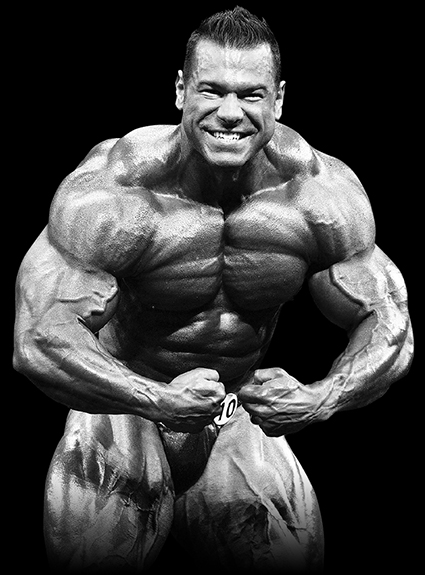The Science of Muscle Growth

Tipping the scale: the psychology of
gaining mass and size
For many people, watching the number on the scale creep up is a scary thought. In fact, it’s the exact opposite of what most of the population is trying to do. The dieting industry rakes in billions of dollars a year, with people spending money on club memberships, weight-loss programs, and supplements to help them drop some pounds. For this reason, it’s no surprise that many people struggle with the idea of purposefully gaining weight.
However, for those of you looking to build the body you’re aiming for, it’s a necessary step. While this can be a hard concept to understand, it pays to take the time off dieting and switch your focus into building muscle mass. To do so, you just need to embrace the weight gain.
The Science of Muscle Growth
Whether you’re a physique athlete entering the off-season or a fitness fanatic looking to build more muscle mass, the rules are the same: train hard, recover, and live in a caloric surplus. When used consistently, these three factors are the key variables to growth.
The first two are usually simple for people who love to train; it’s the third factor that causes some people to reconsider their plans. Entering a caloric surplus can be frightening for some people as they equate it to looking less defined, saying goodbye to their abs, and being generally uncomfortable in their clothes.
 At a physiological level, the body requires energy (calories) in order to build more tissue. For this reason, living in a caloric surplus is necessary when looking to grow. Think of your body as your car’s gas tank. Throughout the day, you use fuel and bring the level down, and when you’re dieting, your calories never fully restore it, leaving you unable to generate new tissue. When you’re looking to grow, you want to keep that tank as full as possible, which will allow you to train hard and fuel your body for rebuilding.
At a physiological level, the body requires energy (calories) in order to build more tissue. For this reason, living in a caloric surplus is necessary when looking to grow. Think of your body as your car’s gas tank. Throughout the day, you use fuel and bring the level down, and when you’re dieting, your calories never fully restore it, leaving you unable to generate new tissue. When you’re looking to grow, you want to keep that tank as full as possible, which will allow you to train hard and fuel your body for rebuilding.
Essentially, living in a caloric surplus can be attained by increasing your calories or by lowering your output, and is often a combination of the two approaches. Doing cardiovascular activities burns calories, making it a useful tool when you’re looking to lose weight, but it can prove to be counterproductive when the focus shifts to growth. Although some cardio is beneficial for health factors, doing hours of it every week will only hinder your ability to grow as it cuts into your caloric intake—something to consider when you’re making your game plan.
Switching the mind-set from a maintenance or dieting phase to one of growth can take time and lifestyle adjustments. You can stop looking for low-carb dieting hacks and find new ways to fill the time you were using for cardio—both of which are good problems to have! For some ideas on how to make a smooth transition into a growth phase, and to aid in enjoying the process, see the “Tips for Embracing the Gains” section.

How Much Is Too Much?
While this seems like a simple enough question, the answer is actually fairly complex with a variety of factors. First and foremost, weight gain is a very individual concept—everyone will have their own personal limits where they feel comfortable, and often don’t want to cross that line. Just as everyone will put on muscle at a different rate, everyone will gain weight and store body fat differently. It’s an unfortunate reality that when growth is your goal, you will accumulate some body fat; it’s unavoidable when living in a caloric surplus. However, when done correctly, a growth phase doesn’t have to equate to an unhealthy body mass index. With the right energy intake for your needs, and proper monitoring along the way, you can keep the body fat at a healthy level.
 For those who are uncomfortable with the idea of gaining weight, it may be a progressive process from year to year. Maybe in your first growth phase you put on 10 pounds of weight, and then in a following year, you’re more comfortable with the idea and put on 15 to 20 pounds. There’s no hard, set rule as to what you need to gain for the benefit of growth.
For those who are uncomfortable with the idea of gaining weight, it may be a progressive process from year to year. Maybe in your first growth phase you put on 10 pounds of weight, and then in a following year, you’re more comfortable with the idea and put on 15 to 20 pounds. There’s no hard, set rule as to what you need to gain for the benefit of growth.
An important aspect to consider is your body composition at the outset of your growth phase. If you already have a healthy amount of body fat, you likely don’t need to actively gain any more. However, if you’re starting from a very lean body composition, like a competitive bodybuilder post-show, your body will need to gain a decent amount of weight. You will absorb calories very quickly right off the start without showing any signs of fat gain because your body’s tank has been running close to empty for so long. The threshold will be reached where the tank is finally full again, at which point calories may need to be pulled back to stop an excessive amount of fat gain.

When the Fear Takes Over
The American Psychiatric Association officially identifies a wide range of body image-related illnesses, which often manifest themselves as harmful food behaviours. These can range from overly restrictive intakes to uncontrolled eating episodes, but all have one thing in common from a clinical perspective: They affect a person’s ability to function day to day and are detrimental to their health.
In the case of a fear of weight gain, there are a few clinical explanations, but it’s important to note that not everyone with a fear falls into one of these categories. In general, pocrescophobia is the irrational fear of gaining weight and is marked by the avoidance of food, an obsession with weight loss, experiencing guilt when eating, and avoiding the use of a scale. This fear can manifest itself as a variety of behaviours, which can be categorized into an eating disorder such as anorexia nervosa at its most extreme.

The fear of gaining weight may stem from health concerns, such as the dangers of gaining too much body fat, or it may purely be rooted in vanity. These outcomes are often seen in athletes participating in aesthetic sports such as figure skating, gymnastics, and in physique competitors, where an extremely fit and lean body is ideal. In many cases, people regard their lean physiques as part of their identities, and the idea of that changing is terrifying as it would represent a loss of themselves.
Although the fear of gaining weight may not cross into dangerous territory, it needs to be addressed if it becomes a health concern or impedes a person’s ability to function from day to day. For example, the female athlete triad is a syndrome marked by low energy intake, amenorrhea (loss of the menstrual cycle), and decreased bone mineral density. This syndrome can negatively affect the athlete’s long-term health status, and requires medical intervention.

 8 Tips for Embracing
8 Tips for Embracing
the Gains
As you kick off your season of gains, the following tips can help you stay on track—and even enjoy the process along the way.
1. FOCUS ON PERFORMANCE Often, the increase in calories and some extra body mass will lead to an increase in strength. This performance change will go a long way in helping you build muscle mass, so focus on that. If it helps, keep track of your major lifts and how much weight you’re moving; sometimes seeing these numbers go up will help you deal with the number on the scale increasing.
2. USE A VARIETY OF MEASUREMENTS Relying solely on a weight scale throughout this process would be a great disservice as it only paints part of the picture. Using a variety of tools, such as progress photos and measurements, can help you truly assess progress throughout your growth phase.
3. EAT A VARIETY OF FOODS Often during a dieting phase, or for someone who has been watching their caloric intake for a prolonged length of time, many foods have been “off-limits” or eaten in very small quantities. Take this time to enjoy a lot of variety with your macro- and micronutrients. Not only is this more enjoyable mentally but it’s also great for your overall health as the restrictions may have resulted in some vitamin or mineral deficiencies.
4. ENJOY YOUR FOOD While this may seem like a no-brainer to most people, the truth is that when you’re eating to grow, it can become a chore. Avoid this issue by cooking your food in a variety of ways and using different seasonings. These factors, along with the previous tip of eating a variety of foods, can help you enjoy all of your meals.
 5. USE A GRADUAL APPROACH If you struggle with the idea of gaining weight, do it gradually. This approach will give you more control and allow you to mentally adjust to the weight gain as it occurs. That being said, there’s a point where weight gain can happen too slowly—especially if it segues right into another dieting phase after only a few pounds have been put on. This rate is going to be different for everyone, but a general guideline to follow is a pound per week, while monitoring your body composition to ensure body fat isn’t accumulating too quickly. Also, holding your weight at a certain point is beneficial too. Your growth phase shouldn’t feature weekly caloric increases to spark massive weight gain each week.
5. USE A GRADUAL APPROACH If you struggle with the idea of gaining weight, do it gradually. This approach will give you more control and allow you to mentally adjust to the weight gain as it occurs. That being said, there’s a point where weight gain can happen too slowly—especially if it segues right into another dieting phase after only a few pounds have been put on. This rate is going to be different for everyone, but a general guideline to follow is a pound per week, while monitoring your body composition to ensure body fat isn’t accumulating too quickly. Also, holding your weight at a certain point is beneficial too. Your growth phase shouldn’t feature weekly caloric increases to spark massive weight gain each week.
6. SET A REALISTIC TIMELINE Having a deadline when the growth phase will switch to a dieting phase can help reassure you. For some people, this deadline may have to be something concrete, such as a vacation, photo shoot, or a special event such as a friend’s wedding. For others, they may not need an event to kick-start the process. In either case, make sure you’ve been realistic by giving yourself enough time to grow—one or two months won’t yield a massive physique change—and also enough time to diet down gradually. The last thing you want to do is crash diet and burn off some of that muscle you worked hard to build!
7. RELY ON HEALTHY FOODS Too often people viewing gaining weight as an open invitation to load up on junk food. Let’s do everyone a favour and permanently remove the term “dirty bulk” from our vocabularies. You will look better, perform better, and feel better when you fill your calories with nutrient-dense foods, at least most of the time.
8. REMEMBER YOUR GOAL It can be easy to get caught up in your concerns over your physical appearance and start dieting again. Sometimes you just need to stop and remind yourself of the long-term goal: the stronger, bigger physique you envision.

Tipping the Scale
For anyone looking to build their physique, weight gain is a necessary part of the process. The increase in calories needed as fuel for tissue growth will bring about some body fat, which can be tough for some people to handle. If you have a hard time staying objective with your progress, and are unsure of the best way to approach a growth phase, hiring a coach may be a valuable investment. Not only will they have your best interest in mind, but they offer an objective view on your physique—something we will always struggle to maintain for ourselves.
The saying “you’ve gotta eat to grow” holds very true, and those who have taken the time to do so have the results to prove it. And remember, the number on the scale shouldn’t be stress- or fear-provoking; it’s only a measurement tool, not a reflection of your hard work, and it definitely doesn’t define you as a person.
Click HERE to sign up for our free newsletter!


